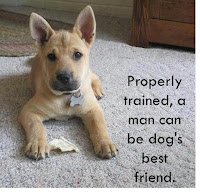Top 10 Puppy Basics – All of these steps are important for a well adjusted puppy.
1. Start socializing your puppy early. As soon as he has had his second set of shots usually (after 10 weeks). Introduce your puppy to as many new environments, people and dogs as possible. The critical socialization period for a puppy is (8-22 weeks).
2. Take your new puppy to the veterinarian with 72 hours of getting your puppy. It's important to get to know your Vet and for your Vet to know you and you puppy, as this will likely be a long term relationship.
Use common sense when it comes to your Vet, if you are not comfortable with how they are handling your dog, or the Vet does not really listen to what you are saying. Shop around and find another Vet. Ask friends who have dogs for their recommendations,
3. Remember an 8 week old puppy is just a baby, play and handle him gently. Do not engage in rough play or encourage play with that involves biting your hands or clothes. This behavior should be immediately corrected and give the puppy a toy or object he is allow to chew.
Puppies bite/chew and nip, it's our job to teach our puppies what they can and can't bite and what is appropriate play. What is cute as puppy is not so cute in an 80 pound dog.
4. Introduce your puppy to new children and other puppies and dogs slowly. You want every new experience for your do to be a positive one. If your puppy has a negative experience at an early age it could effect his behavior for life, so make sure each new situation is short and positive. Give your puppy lots of praise.
5. Good quality puppy food is very important for the healthy growth of your puppy. Poor quality food may lead to a lifetime of health issues. Do your homework and make sure you are getting the best quality for your breed of dog. Click here for a list of homemade dog treat recipes you can make your dog, click the recipe name to take you to the full recipe.
6. Begin house training the first day you get home. Decide a head of time how you want to potty train your puppy(using puppy pad, going directly outside, using a crate) and be prepared for when you bring your new addition home. 8week old puppies need to go to the bathroom approx every 1-2 hours. The rule of thumb is 1 hour for each month they are. Click here to read "Housebreaking -Training for Success"
7. Don’t inadvertently encourage bad dog behavior. Jumping up, biting, barking, begging for table food. It is so important to correct these behaviors right from the start. It is much easier to teach your puppy the right things to do then it is to correct bad behaviors that he has been allowed to do for months. Remember, what is cute and adorable when your puppy is 8 weeks old will be far from cute when they are grown.
8. Never use food rewards for correcting behaviors. Food rewards should only be used when teaching your dog his commands(sit, come, stay, down, etc....).
If you correct your puppy for jumping up and he goes down, you give him a food reward, you have just encouraged your dog to perform bad in order to get a reward.
Remember, only give food rewards when your dog has done work like sit, stay or come. Only give love as his reward for correcting bad behaviors.
9. When correcting your puppy's behavior, NEVER do anything that will hurt, harm, embarrass, humiliate or loss of dignity. Puppies need love, patience and consistency are your best tools.
10. Have a variety of toys for your puppy, a soft one, a chewy one, a tug toy. See which type of toys your puppy likes to play with more and get him the toys he like rather then spending lots of money on toys they never play with.
Puppies also need a variety of toys for teething, some toys offer more comfort for those teething times.
I highly recommend taking a Puppy Training Class. It is so important for you to learn how to teach your puppy. This is a long commitment you have made, it's your responsibility to learn how to do things the right way. If you spend your puppy's first year working hard and training, you will have the next 10-16 years of having that awesome dog.
Note: Make sure your new puppy has identification in the event that he gets lost. It’s a good idea to identify your dog with an ID tag as well as a dog tattoo or microchip.
If you have any questions about your new puppy, please post it on the comments and I will respond ASAP.
Puppy Milestones:
Puppy is ready to take home 8 weeks
Housebreaking 6-8 weeks
Bathing 7-8 weeks
Obedience training 8-10 weeks
Socialization 8-22 weeks
Heartworm prevention 3 months
Spay or neuter 6-9 months
When is a puppy full grown 1- 1½ years


.jpg)
.jpg)

.jpg)









